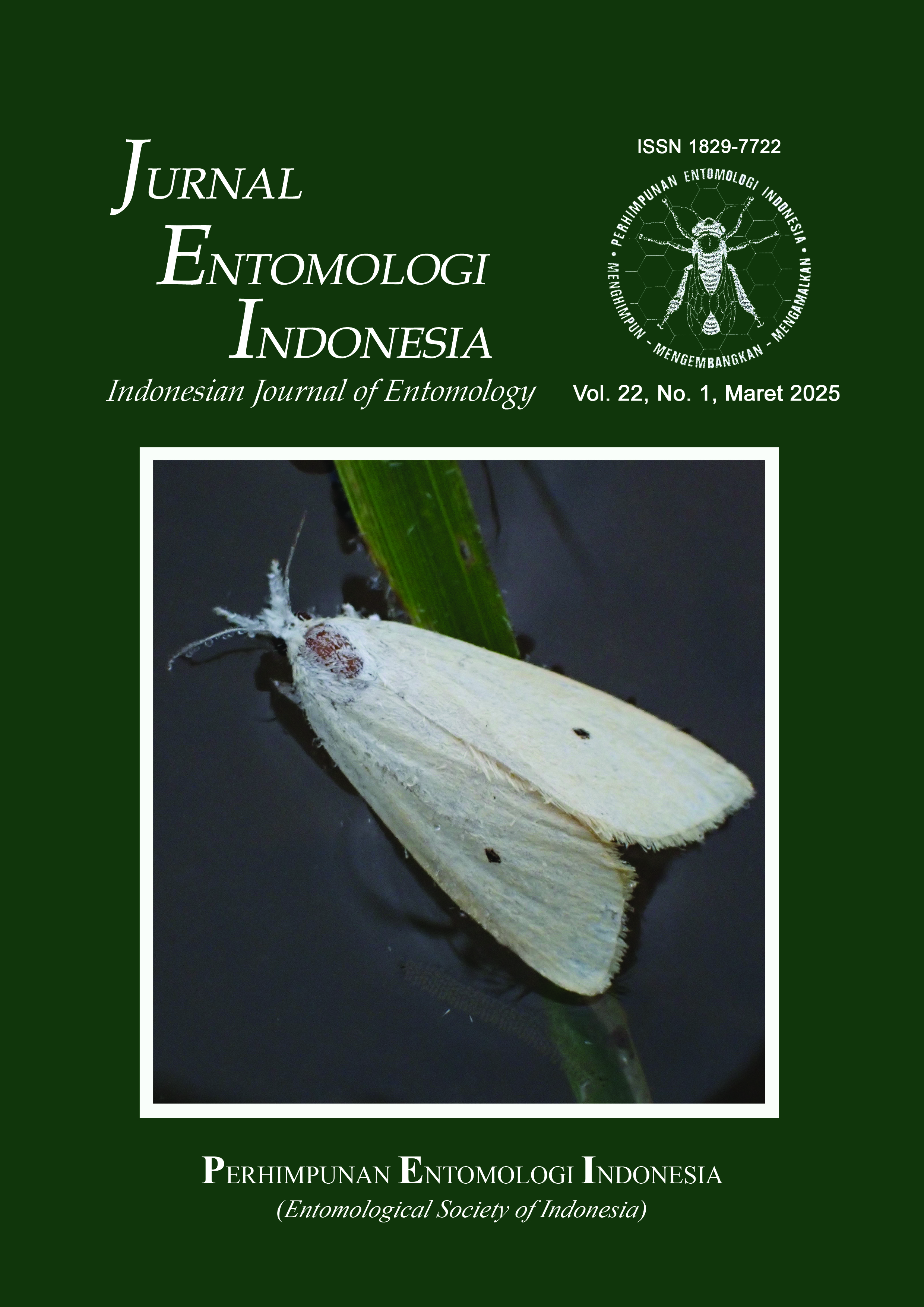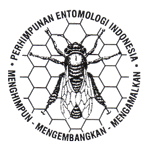Eksplorasi potensi budi daya lebah madu Apis cerana Fabricius di Taman Kehati Kiarapayung, Jawa Barat
Exploration of the potential of Apis cerana Fabricius beekeeping in the Kiarapayung Biodiversity Park, Jawa Barat
DOI:
https://doi.org/10.5994/jei.22.1.1Keywords:
biodiversity, food source, Sumedang, sustainable conservationAbstract
This study examines the potential for rearing Apis cerana Fabricius honey bees in Taman Kehati Kiarapayung, West Java. Observations were conducted by installing 39 beehive in various locations and observing the flora that serve as bee food sources. A total of 50 plant species from 24 families were identified as bee food sources. Out of the 39 beehive, only 4 were successfully inhabited by bee colonies, showing a success rate of 10.3%. The observed colony growth ranged from 3 to 9 honey combs per hive. The main challenges in cultivation are the decrease in food availability during the dry season with very low rainfall, and pest disturbances such as wax moths (Galleria mellonella), wasps (Vespa sp.), and ants (Formicidae). The results of this study indicate that A. cerana beekeeping has the potential to be implemented in specific locations with sufficient food availability and effective pest management. This potential can serve as an additional source of income for the local community and support environmental conservation efforts by utilizing biological resources and biodiversity in a non-destructive manner at conservation sites.
Downloads
References
Agussalim, Agus A, Umami N, Budisatria IGS. 2017. Variation of honeybees forages as source of nectar and pollen based on altitude in Yogyakarta. Buletin Peternakan. 41:448−460. DOI: https://doi.org/10.21059/buletinpeternak.v41i4.13593.
Aluri JSR, Rani D. 2017. Pollination ecology of Triumfetta rhomboidea (Tiliaceae). Annali di Botanica. 7:33−41.
Aluri, JSR, Rao KRSS. 2018. Nesting behavior and foraging ecology of dammer bee, Trigona iridipennis Smith (Apidae: Meliponinae). Advances in Pollen-Spore Research. 36:191−236.
Asfiya W, Winara A, Ruswandi IA, Prativi MBN, Yulie Budiasih S, Kahono DS, Narakusumo RP, Encilia MS, Darmawan, Sarino, Pasthikaningrum A, Rahayu TY, Yulia. 2023. Potensi Ekowisata Berbasis Lebah Madu Sebagai Strategi Konservasi Berkelanjutan: Studi Kasus di Taman Kehati Kiara Payung. Bandung: Badan Penelitian dan Pengembangan Daerah Provinsi Jawa Barat.
Biella P, Ssymank A, Galimberti A, Galli P, Perlík M, Ramazzotti F, Rota A, Tommasi N. 2022. Updating the list of flower-visiting bees, hoverflies and wasps in the central atolls of Maldives, with notes on land-use effects. Biodiversity Data Journal. 10:1−26. DOI: https://doi.org/10.3897/BDJ.10.e85107.
Budumajji U, Raju AJS. 2018. Pollination ecology of Bidens pilosa L. (Asteraceae). Taiwania. 63:89−100.
Chauhan SVS, Nisha. 2018. Reproductive biology of Alstonia scholaris (L.) R. Br. (Apocynaceae). The International Journal of Plant Reproductive Biology. 10:119−126.
Domínguez RQ, Larios LDLC, Eguiarte DRG, Magallanes JAS, Michel JFS, Carrillo JLR. 2021. Corbicular pollen spectrum (Apis mellifera) of samples from Huejotitan, Jalisco, Mexico. Revista Mexicana de Ciencias Pecuarias. 12:621−632. DOI: https://doi.org/10.22319/rmcp.v12i2.4398.
Estes J. 2018. Anther number, anther apical appendages, and pollination biology of Calyptocarpus vialis Lessing (Heliantheae: Asteraceae). Oklahoma Native Plant Record. 18:45−51. DOI: https://doi.org/10.22488/okstate.19.100005.
Gupta RK. 2021. Taxonomy and distribution of different honeybee species. In: Gupta RK, Reybroeck W, Veen JWV, Gupta A. (Ed.), Beekeeping for poverty alleviation and livelihood security. Dordrecht: Springer.
Harianja AH, Adalina Y, Pasaribu G, Winarni I, Maharani R, Fernandes A, Saragih GS, Fauzi R, Tampubolon AP, Njurumana GN, Sukito A, Aswandi A, Kholibrina CR, Siswadi S, Kurniawan H, Hidayat MY, Wahyuni R, Koeslulat EE, Heryanto RB, Basuki T, Da Silva H, Ngongo Y, deRosari BB, Waluyo TK, Turjaman M, Prabawa SB, Kuspradini H. 2023. Potential of beekeeping to support the livelihood, economy, society, and environment of Indonesia. Forests. 14:321. DOI: https://doi.org/10.3390/f14020321.
Jasmi, Putra DP, Syarifuddin, Herwina H, Janra MN. 2021. Breeding efforts on wild honey bee Apis cerana Fabr. within coconut plantations in Padang Pariaman, West Sumatra. IOP Conference Series: Earth and Environmental Science. 757:012024. DOI: https://doi.org/10.1088/1755-1315/757/1/012024.
Kahono S. 1992. Pengamatan sumber pakan dan aktifitas lebah madu asia (Apis cerana F.) untuk menunjang budidaya di Desa Pasir Eurih, Kecamatan Ciomas, Kabupaten Bogor, Jawa Barat. Buletin Peternakan. 16:120−126. DOI: https://doi.org/10.21059/buletinpeternak.v16i1.1747.
Kastolani W. 2018. How to conservate in situ and ex situ community based biodiversity park in Sumedang regency of West Java Province? IOP Conference Series: Earth and Environmental Science. 145:012091. DOI: https://doi.org/10.1088/1755-1315/145/1/012091.
Koetz AH. 2013. Ecology, behaviour and control of Apis cerana with a focus on relevance to the Australian incursion. Insects. 4:558−92. DOI: https://doi.org/10.3390/insects4040558.
Kowalczuk I, Gębski J, Stangierska D, Szymańska A. 2023. Determinants of honey and other bee products use for culinary, cosmetic, and medical purposes. Nutrients. 15:737. DOI: https://doi.org/10.3390/nu15030737.
Layek U, Das A, Das U. 2022. Floral biology, floral volatile organic compounds and floral visitors of Chromolaena odorata, an invasive alien species in West Bengal, India. Biodiversitas. 23:2118−2129. DOI: https://doi.org/10.13057/biodiv/d230447.
Lima IS, Pinto KDS, Franca FB, Brightenti CRG, Serpa DC, Brightenti DM. 2019. Bayesian approach of the logistic model in the study of glyphosate herbicide in African bees. Sigmae. 8:282−289.
Liu F, Gao J, Di N, Adler LS. 2015. Nectar attracts foraging honey bees with components of their queen pheromones. Journal of Chemical Ecology. 41:1028−36. DOI: https://doi.org/10.1007/s10886-015-0642-2.
Mohammad SM, Nor-Khaizura MAR, Zawawi N. 2020. Botanical origin and nutritional values of bee bread of stingless bee (Heterotrigona itama) from Malaysia. Journal of Food Quality. 2020:1−12. DOI: https://doi.org/10.1155/2020/2845757.
Nasution MJ, Khairul RH. 2019. Sumber pakan lebah madu (Apis cerana Fab.) di Kecamatan Rantan Selatan Kabupaten Labuhan Batu. Jurnal Pendidikan Biologi Nukleus. 5:8−18. DOI: https://doi.org/10.36987/jpbn.v5i1.1156.
Noriega JA, Hortal J, Azcárate FM, Berg MP, Bonada N, Briones MJI, Del Toro I, Goulson D, Ibanez S, Landis DA, Moretti M, Potts SG, Slade EM, Stout JC, Ulyshen MD, Wackers FL, Woodcock BA, Santos AMC. 2018. Research trends in ecosystem services provided by insects. Basic and Applied Ecology. 26:8−23. DOI: https://doi.org/10.1016/j.baae.2017.09.006.
Nuriyah S, Anshory Yusuf A, Hermawan W, Husodo T. 2021. Ecosystem services from honey beees Apis cerana Fabr. in Taman Hutan Raya (Tahura) Ir. H. Djuanda Dago Expert Bandung ecology and economically. E3S Web of Conferences. 249:03016. DOI: https://doi.org/10.1051/e3sconf/202124903016.
Ollerton J, Winfree, R, Tarrant, S. 2011. How many flowering plants are pollinated by animals? Oikos. 120:321−326. DOI: https://doi.org/10.1111/j.1600-0706.2010.18644.x.
Pribadi A. 2016. Hutan tanaman industri jenis Eucalyptus sp. sebagai pakan lebah madu di Riau. Info Teknis Eboni. 13:105−118.
Pulungan ZN, Priawandiputra W, Grass I, Li K, Robo RJ, Raffiudin R. 2023. Tropical lowland rainforest conversion to rubber monoculture affects flight activity and pollen resources of the stingless bees Tetragonula laeviceps (Smith). Jurnal Entomologi Indonesia. 20:88−100. DOI: https://doi.org/10.5994/jei.20.1.88.
Quijano-Abril M, Castaño M, Marín Henao D, Sánchez Gómez D, Rojas JM, Sierra Escobar JA. 2021. Functional traits of the invasive species Thunbergia alata (Acanthaceae) and its importance in the adaptation to Andean forests. Acta Botanica Mexicana. 128:e1870.
Sritongchuay TU, Bumrungsri SA. 2016. Effects of forest proximity on fruit set and visitor body size of Sandoricum koetjape (Burm. f.) Merr. in Southern Thailand. Malayan Nature Journal. 69:91−98.
Uyun W, Karnan, Yamin M. 2022. The preference of Trigona sp for pollen various plant species in kawasan Rumah Pangan Lestari. Jurnal Biologi Tropis. 22:131−141. DOI: https://doi.org/10.29303/jbt.v22i1.3061.
Downloads
Published
How to Cite
Issue
Section
License
Copyright (c) 2025 Wara Asfiya, Aji Winara, Mahensa Billqys Nurhayati Prativi, Agus Ruswandi, Raden Pramesa Narakusumo, Encilia, Alex Sumadijaya, Sih Kahono, Darmawan, Sarino, Yulie Budiasih, Laras Ayu Hapsari

This work is licensed under a Creative Commons Attribution 4.0 International License.
Authors who publish with this journal agree to the following terms:
- Authors retain copyright and grant the journal right of first publication with the work simultaneously licensed under a Creative Commons Attribution 4.0 International License that allows others to share the work with an acknowledgement of the work's authorship and initial publication in this journal.
- Authors are able to enter into separate, additional contractual arrangements for the non-exclusive distribution of the journal's published version of the work (e.g., post it to an institutional repository or publish it in a book), with an acknowledgement of its initial publication in this journal.
- Authors are permitted and encouraged to post their work online (e.g., in institutional repositories or on their website) prior to and during the submission process, as it can lead to productive exchanges, as well as earlier and greater citation of published work (See The Effect of Open Access).








